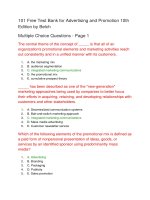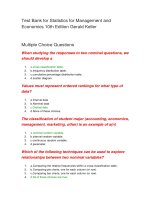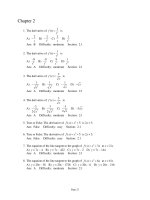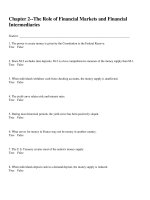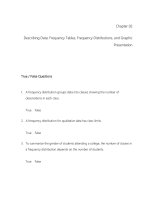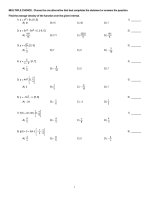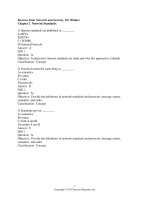Public speaking for college and career 10th edition gregory test bank
Bạn đang xem bản rút gọn của tài liệu. Xem và tải ngay bản đầy đủ của tài liệu tại đây (131.5 KB, 4 trang )
Chapter 2 Managing Nervousness
Chapter 2 (Form A)
Name _________________________
True or False If the statement is true, circle T; if false, circle F.
T F
1.
Most of your nervous symptoms are not seen by your audience.
T F
2.
In filling your mind with images before a speech, you should
picture yourself speaking with confidence, poise, and
completely without nervousness.
T F
3.
Gesturing or walking around a bit during your speech helps
siphon off excessive nervous energy.
T F
4.
In preparation for a speech, a person should read over his or
her notes rather than actually rehearse the speech.
T F
5.
A good speaker tries very hard to eliminate all fear and
nervousness.
T F
6.
If your hands tremble or you show some other sign of
nervousness, you should apologize to your audience or try to
make a joke out of your problem.
T F
7.
If you see people whispering during your speech, you should
assume that they are exchanging negative comments about
you or your speech.
T F
8.
A shy person’s shyness will block that person from giving a
good, dynamic speech.
T F
9.
Memorizing a speech is a bad technique for handling
nervousness.
T F
10.
If you feel yourself approaching panic (your heart is beating
furiously and so on), you should leave the room or ask to be
excused from speaking.
Gregory: Public Speaking for College and Career, 10e
TB-2 | 1
© 2013 by McGraw-Hill Education. This is proprietary material solely for authorized instructor use. Not authorized for sale or
distribution in any manner. This document may not be copied, scanned, duplicated, forwarded, distributed, or posted on a website, in
whole or part.
Chapter 2 Managing Nervousness
Chapter 2 (Form B)
Name __________________________
Multiple-Choice Questions Each question has only one correct answer.
___
1.
Feeling awkward, uneasy or apprehensive in public because of
your genetic makeup or temperament is called (a) genetic
vulnerability, (b) social anxiety, (c) public humiliation, (d) sensitive
temperament
___
2.
According to the text, shyness (a) is a personal defect, (b) is a
barrier to effective public speaking, (c) can be eliminated by
psychotherapy, (d) is a characteristic of some successful people in
show business
___
3.
According to the text, “locking” your eyes with a listener’s eyes
(a) intensifies your anxiety, (b) makes the listener uneasy, (c)
demonstrates that you have no fear, (d) helps to calm you
___
4.
Public speakers should regard their task as (a) communication only,
(b) performance only, (c) both communication and performance, (d)
communication, performance, and duty
___
5.
When practicing your speech, devote extra time to (a) the
introduction, (b) the body, (c) the conclusion, (d) the question-andanswer period
___
6.
Acting as if you are poised and confident (a) is a pretense that the
audience will immediately see through, (b) sometimes leads to
actually becoming poised and confident, (c) will make you even
more nervous than before
___
7.
If, during a speech, your mind goes blank and you forget where you
are in the speech, the text recommends that you (a) apologize and
sit down, (b) start over from the beginning, (c) make a joke about
your predicament, (d) ask the audience, “Where was I?”
___
8.
Which of the following does the text recommend as a way to
release tension? (a) inhale and exhale slowly, (b) mentally prepare
for a panic attack, (c) make a joke about your nervousness, (d)
arrive precisely one minute before your speech
___
9.
According to the text, a sudden bolt of panic can hit speakers who
(a) overprepare, (b) initially feel no fear, (c) dislike the audience, (d)
have poor self-esteem
___
10.
The term used by the text for visualizing successful actions is (a)
creative imagination, (b) positive imagery, (c) success orientation,
(d) power visualization
Gregory: Public Speaking for College and Career, 10e
TB-2 | 2
© 2013 by McGraw-Hill Education. This is proprietary material solely for authorized instructor use. Not authorized for sale or
distribution in any manner. This document may not be copied, scanned, duplicated, forwarded, distributed, or posted on a website, in
whole or part.
Chapter 2 Managing Nervousness
Chapter 2 (Form C)
Name __________________________
Multiple-Choice Questions Each question has only one correct answer.
___ 1.
Switching your thoughts from “I’m going to fail” to “I will give the audience
some good information” is a technique known as changing your (a)
opinion, (b) perception, (c) self-talk, (d) outlook
___ 2.
If you flub a sentence or mangle an idea during a speech, you should (a)
stop and apologize for your blunder, (b) pause and correct yourself without
apologizing, (c) apologize and sit down immediately, (d) make a joke
about hating speechmaking
___ 3.
The greatest amount of anxiety in a speech is usually experienced in the
(a) introduction, (b) body, (c) conclusion, (d) question-and-answer period
___ 4.
To avoid memory lapses during a speech, (a) memorize basic facts before
the speech, (b) prepare a word-for-word script, (c) prepare a card with key
information on it, (d) learn to eliminate nervousness
___ 5.
A public speaker who tries to eliminate all fear is pursuing a goal that is (a)
desirable, (b) impossible, (c) unimportant, (d) undesirable
___ 6.
To gain rapport with their audiences, some comedians (a) pretend to have
stage fright, (b) deliberately make mistakes, (c) go out into the audience to
shake hands, (d) playfully “insult” some listeners
___ 7.
Striving for perfection (a) helps you to achieve almost total perfection, (b)
is a necessary mental ploy to achieve success, (c) is the best way to
develop a positive outlook, (d) places unnecessary pressure on yourself
___ 8.
The text says that worrying about yourself and your image in a speech is a
kind of (a) motivation, (b) vanity, (c) self-defense, (d) awareness
___ 9.
The term used by the text to describe “a zesty, enthusiastic, lively feeling
with a slight edge to it” is (a) positive nervousness, (b) focused
enthusiasm, (c) managed anxiety, (d) heightened sensitivity
___ 10. Which of the following was mentioned in the text as a way to manage
nervousness? (a) arrive just a few moments before your speech, (b) act as
if you are already poised and confident, (c) encourage listeners to ask
questions throughout the speech, (d) look at a fixed point on the wall in the
back of the room
Gregory: Public Speaking for College and Career, 10e
TB-2 | 3
© 2013 by McGraw-Hill Education. This is proprietary material solely for authorized instructor use. Not authorized for sale or
distribution in any manner. This document may not be copied, scanned, duplicated, forwarded, distributed, or posted on a website, in
whole or part.
Chapter 2 Managing Nervousness
Chapter 2 (Form D)
Name _______________________
Fill in the missing words or phrases.
1.
Fear of public speaking can be caused by a ______________
event in your past.
2.
Pretending to be confident can sometimes cause you to
become a ___________________________ speaker.
3.
Of all parts of the speech, you should devote extra practice time
to ___________________________.
4.
The text cites an old saying, “Speakers who say they are as
cool as a cucumber usually give speeches about as interesting
as a ___________________________.”
5.
According to the text, the very best precaution against
excessive stage fright is ___________________________.
6.
Positive ___________________________ is a technique used
by golfers as well as public speakers to visualize success.
7.
Speakers can manage nervousness and enhance their
speeches if they think of speechmaking as communication,
rather than as ___________________________.
8.
Concerning most speakers, the audience is
___________________ of their physical symptoms such as
pounding heart and trembling knees.
9.
Some comedians deliberately plan
_________________________ as a technique for gaining
rapport with an audience.
10.
Making a joking, lighthearted comment about your nervousness
is a ___________________________ technique for a speaker
to use.
Gregory: Public Speaking for College and Career, 10e
TB-2 | 4
© 2013 by McGraw-Hill Education. This is proprietary material solely for authorized instructor use. Not authorized for sale or
distribution in any manner. This document may not be copied, scanned, duplicated, forwarded, distributed, or posted on a website, in
whole or part.
